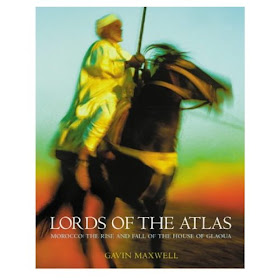Our guest contributor, Barnaby Rogerson, returns for the first time in 2012 with a tale of a book that inspired his Moroccan adventures.People fall for Marrakech for a myriad of reasons. The hidden palaces, the street musicians, shopping in the great covered souk, the dry heat that extends well into the winter months and the palpable sense of bustling glamour. The great circuit of red walls watched over by medieval towers and set against the shear backdrop of the High Atlas mountains is of itself a photographic definition of Oriental glamour. But for me, it was a book that was to blame for my long love affair with Morocco and its red walled city: Gavin Maxwell's gripping history, Lords of the Atlas.
I must have read the book at least six times. Yesterday I glanced once again at the handsome new edition published by Cassell, and turned to the opening lines: "The castle, or kasbah, of Telouet is a tower of tragedy that leaves no room for laughter. The double doors to the forecourt are twenty feet high. A giant Negro slave opens the lock with a key a foot long. He carries sixty-seven keys. He has been in charge of Telouet for three years, but even now he does not know his way through the labryinth.." It only took the first page and I was hooked again.
In the book, Maxwell chronicles the story of the Glaoua clan, a petty dynasty of Berber chieftains whose domain was perched up in the cleft of the High Atlas. They rose to power and wealth as government ministers in the intrigue-ridden years of the 1900's when the Moroccan Sultans were struggling to preserve their independence from the predatory powers of Europe. They backed France, which proved to be the right horse, and rose to become virtual Viceroys of Southern Morocco during the subsequent French Protectorate. In the process they built a series of magnificent kasbahs to control the mountains and oasis valleys of the pre-Sahara. However the moment the French left and Morocco recovered its Independence in 1956, the Glaoua fell from their high estate. Their fortune, their estates, their armies disappeared overnight - like a mirage of princely power.
 |
| Much of the Glaoui stronghold Telouet is now a ruin |
To a foreign traveller, the Glaoua might still appear the very definition of glamour. It is a very different story for a Moroccan, for to the home audience the Glaoua have all the appeal of a Quisling to a Norwegian or a Vichy collaborator to a hero of the Resistance. They were the paid henchmen of the French Colonial regime, entrusted with all the nasty work and most of the treachery. They also deliberately exploited the ethnic differences between Arab and Berber for the sole benefit of a foreign power. Love of the Glaoua is only possible from a very Western perspective.
 |
| Thami El Glaoui |
Thami, the ruling Pasha of the Glaoua from 1918-56 was full of improbable contradictions: personally made a knight by King Edward VII, he also had Edward G. Robinson as a son-in law but was proud to wear only the traditional clothes woven by the women of his family. His palaces were equipped with cinemas, courtyards filled with concubines and well-stocked dungeons underground. He built the first golf course in Morocco - just outside Marrakech (near the Amanjena) and kept the greens watered throughout a four- year-long drought. He gave emeralds to his guests, could raise a dust storm with his convoys of Hispano-Suiza‚s or raise an army of tribesman overnight. His guest list started at the top, he lavished hospitality on Churchill and Roosevelt, in his palace at Marrakech and in the mountains.
The Glaoua could also build. They built with an external severity and an internal delicacy that no-one else has quite matched. In Western terms, think London‚s brutalist National Theatre for an outside equipped with a Frick Museum or Café Royale interior. In Eastern terms, we are talking the traditional mud brick architecture of the Berber south encasing courtyards from Granada‚s Alhambra.
If you gave yourself a week in the Amanjena, itself set in the Palmeraie, on the edge of one of the clan's golf courses, you would have just about enough time to check out the major Glaoua sites. First off is the great town-palace of the Thami el Glaoua, the Pasha of Marrakech, in the heart of the old city. A place where 'nothing was impossible', guests could experiment with hashish, opium, Chateau Lafitte or a Berber girl or boy from the High Atlas. Sacked by a mob after the Pasha's death, its zellij walls, garden courtyards and cedar roofed dining room are still a vision of opulence.
 |
| View from Telouet in the Atlas |
Barnaby Rogerson is co-publisher at Eland Books and has written guidebooks to Morocco, Tunisia, Cyprus and Istanbul, which were followed by A Traveller's History of North Africa ,The Prophet Muhammad, Heirs of the Prophet Muhammad, and most recently, The Last Crusaders: East, West, and the Battle for the Center of the World. His collected travel journalism and book reviews can be found at www.barnabyrogerson.com
SHARE THIS!


No comments:
Post a Comment